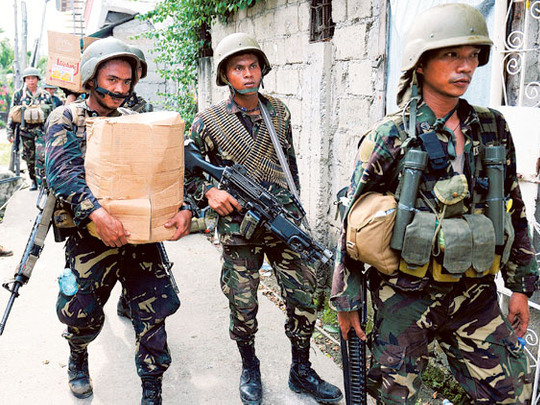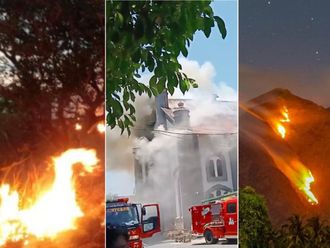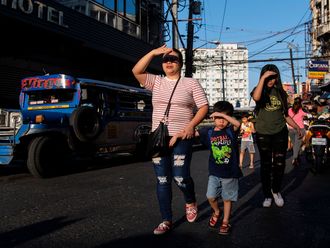
Manila: Nur Misuari, founding chairman of the 44-year-old Moro National Liberation Front (MNLF), has historical and territorial reasons for waging armed struggle twice — in 2001 in Sulu and in Zamboanga that started on September 9 — despite having twice signed pro-autonomy (non-secessionist) peace settlements with the Philippine government, in 1976 and in 1996. Is his restlessness and disappointment symbolic of the true desires of an estimated eight million Filipino-Muslims in the southern Philippines?
Here’s an excerpt of an interview with former Senator Aquilino Pimentel, author of the Organic Act, which paved the way for a referendum for autonomy that brought about the existing Autonomous Region in Muslim Mindanao (ARMM).
Q: Why did the Misuari faction take over six villages in Zamboanga?
Pimentel: Misuari said he is disowning the MNLF commanders who occupied the six villages in Zamboanga. Whether this is true or not, it is a sign that the Philippine government should offer a holistic approach in negotiating for peace with the warring Filipino-Muslims in the southern Philippines.
Q: What could be this holistic approach?
Pimentel: We should offer space, enhanced governance and more power, which could be done through a federal form of government.
Q: What will happen if this is not done?
Pimentel: A temporary solution can only give temporary peace. Otherwise, tomorrow another group will come up and there will an endless cycle of factions that are aiming for armed rebellion in the southern Philippines.
Q: So far, what kind of resolution has the Philippine government offered to at least two major Filipino-Muslim rebel groups?
Pimentel: There was an offer of wide area, about 13 provinces and nine cities, for the Filipino-Muslims in the south when the Philippine government and the MNLF forged the Tripoli Agreement in Libya in 1976. However, former President Ferdinand Marcos issued two presidential decrees creating two functional autonomous areas in the south, composed of about four Muslim-dominated provinces, which did not satisfy Misuari.
Q: Did this promt Misuari to renew his armed struggle?
Pimentel: Although Misuari was dissatisfied, several revolutionaries saw him as a co-opted rebel leader. The MNLF was divided and the Moro Islamic Liberation Front became a faction in 1978.
Q: Which means?
Pimentel: Quietly, the MILF became strong until it became a force to reckon with.
Q: And what was the second response of the government to the problem?
Pimentel: After the ouster of Marcos in 1986, President Corazon Aquino wanted to continue talking with the MNLF, not the MILF. When I became a senator, a measure that called for referendum for autonomy was passed. Its implementation was still based on the Tripoli Agreement of 1976, because referendum for autonomy was held in 13 provinces (as stated in the Philippine government and MNLF peace agreement).
Q: Did the Filipino-Muslim rebels get the area that Misuari wanted for the autonomous Filipino-Muslim region?
Pimentel: Only four provinces voted to be part of the Autonomous Region in Mulsim Mindanao (ARMM).
Q: Were the Filipino-Muslims satisfied with that?
Pimentel: They were given the power to pass laws, not just ordinances which, I think, has empowered them.
Q: So why were negotiations held again between the Philippine government and the MNLF starting 1992?
Pimentel: At the time, Misuari got the help of Indonesia to urge the Philippine government to resume talks and settle the remaining grievances of the MNLF. Indonesia also imposed that the MNLF should give up totally its threat of secession. This had the support of the Organisation of Islamic Conference (OIC).
Q: When the Philippine government and MNLF peace settlement was forged in 1996, it paved the way for a second referendum for autonomy. Can we say that the MNLF wanted just additional province or city for the MNLF, since that was the result of the second referendum for autonomy? (The ARMM is now composed of five provinces and one city).
Pimentel: Why not? The ARMM has a mechanism of empowerment in terms of making laws. Part of the Philippine government and MNLF peace settlement included wealth sharing which was never implemented.
Q: Was the pro-autonomy peace initiative of the Philippine government and the MILF in 1997 meant to persuade the MILF to give up its secessionist stance?
Pimentel: Yes, and much more.
Q: In what way are these negotiations going better for the Filipino-Muslims?
Pimentel: In a sense, the Philippine government-MILF peace talks are sort of implementing what were not done in the Philippine government-MNLF peace talks.
Q: Please explain this in detail.
Pimentel: There are talks about wealth and power sharing which means enhanced self-rule leading to a federal form of governance.
Q: Can we say that the MNLF laid the ground for a wide area for Filipino-Muslims in the south?
Pimentel: Yes, because the ongoing Philippine government-MILF peace talks include expansion of the autonomous area based on the result of the 2001 referendum for autonomy. (Some six towns and 800 Muslim-dominate provinces at the time wanted to be part of the ARMM).
Q: Can you say that the Philippine government-MILF peace talks are advancing the cause of the Filipino-Muslims in the south?
Pimentel: In the sense that their aspirations for self governance is being implemented through a new form of government.
Q: Is Misuari envious of this achievement?
Pimentel: He felt he was left out. He wanted to tell the government, ‘You [in government] made commitments to us [in the past and now] you are talking about the same thing with the MILF.
Q: Shouldn’t the two rebel groups unite?
Pimentel: That is why Misuari feels the government should continue talking with the MNLF while it negotiates with the MILF.











